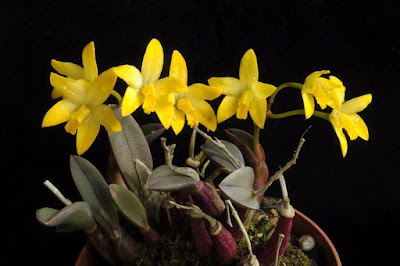Cattleya bradei is found in Minas Gerais, Brazil. Its natural habitat is the rocks covered with lichens, where it grows in the cracks, at an altitude of 1200-1400 meters...
Cattleya bradei also called as Brade's Cattleya, Laelia bradei, Hoffmannseggella bradei, Sophronitis bradei, is a species of the genus Cattleya. This species was described by Cássio Van den Berg in 2008.
IDENTIFY CATTLEYA BRADEI
Cattleya bradei is found in Minas Gerais, Brazil. Its natural habitat is the rocks covered with lichens, where it grows in the cracks, at an altitude of 1200-1400 meters.
It is a mini-miniature sized, cool growing lithophyte with cylindrical, 4 cm long pseudobulbs carrying 2, apical, elliptic, fleshy, 2-4 cm long leaves with incurved margins.
Brade's Cattleya blooms in the late spring and early summer on an erect, terminal, 6 cm long, laxly few flowered inflorescence. The bright yellow flowers are up to 3.5 cm in diameter.
CATTLEYA BRADEI CARE AND CULTURE
Cultural information should only be used as a guide, and should be to be adapted to suit you. Your physical location; where you grow your plants, how much time you have to devote to their care, and many other factors, will need to be taken into account. Only then can you decide on the cultural methods that best suit you and your plants.
Light:
Cattleya bradei needs a light level of 25000-35000 lux, with the 12-hours photoperiod. The direct morning sun is welcome, but from May to August it is advisable to shield it during the hottest hours (12h-16h).
Temperature:
The average temperature in summer is 24-26 ° C during the day and 16-17 ° C at night. The average temperature in winter is 21-23 ° C during the day and 11-12 ° C at night.
Humidity:
Brade's Cattleya needs the humidity of 80%, in winter it drops to 70-75%.
Substrate, growing media and repotting:
Cattleya bradei are usually grow in a vase. As a substrate, a mixture of pumice stone, lava rock and seramis is ideal, which is very light and does not suffocate the roots of the orchid. It is important to choose a medium-small pot (compared to the size of the plant), at most to accommodate the new growths of two seasons, because in a large pot there is a risk that the substrate will remain too wet for longer. During the repotting, as far as possible, we try not to ruin the roots: this orchid does not like to be disturbed, and a further loss of roots could provoke a not indifferent stress. To minimize the effects, the repotting are carried out in the growing period.
Watering:
During the growing period (March-September) this species must get water frequently but so that the substrate dries quickly and remains just wet during one watering and the other without becoming dry.
Fertilizer:
This species is fertilized using 1/4 of the dose indicated on the bottle of a suitable liquid manure for orchids, adding it to the watering water once every 7-10 days. During the rest period the fertilizations are suspended.
Rest period:
To get the right development, Cattleya bradei needs a winter rest period from December to February. It is characterized by lower temperatures ( 21-23 ° C during the day and 11-12 ° C at night) and by very small quantities of water. The watering in this period is carried out so that the substrate remains just wet. If an excessive puckering of pseudobulbs is noticed, the frequency of watering must be increased. Also, let's not forget that the air humidity around the plant must be 70-75%. At the beginning of March (or as soon as the new jets emerging from the base of the pseudobulbs are seen) the orchid rest period gradually ends, and all the values return to normal levels.















COMMENTS